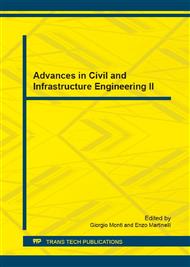p.281
p.290
p.299
p.307
p.319
p.325
p.333
p.339
p.347
Interaction between Building Collapse and Road Serviceability during Seismic Emergency Operations in Urban Centers
Abstract:
In this paper a procedure for the evaluation of the interaction between existing buildings’ seismic damage and residual roads’ serviceability is proposed. The problem of the interaction between jutting buildings and roads is relevant in the seismic assessment of the residual functionality of roadway networks belonging to urban centres, where, in general, the urbanization has shown lack of road networks’ residual connectivity in the past quake experiences. The study proposes a comprehensive approach for the probabilistic assessment of the residual functionality of the urban network links, moving from the execution of the buildings external surveys, the application of probabilistic concepts and the use of fuzzy logic with the final aim to outline the potential urban network damage scenarios. The methodology is applied to the municipality of Conegliano (North-Eastern Italy) evaluating the potential seismic damage scenarios to the historical urban centre and highlighting the potential criticalities in the post-earthquake rescue operations.
Info:
Periodical:
Pages:
319-324
Citation:
Online since:
July 2016
Price:
Сopyright:
© 2016 Trans Tech Publications Ltd. All Rights Reserved
Share:
Citation:


